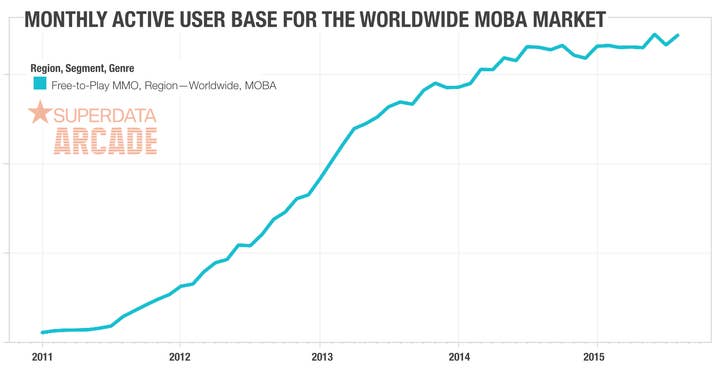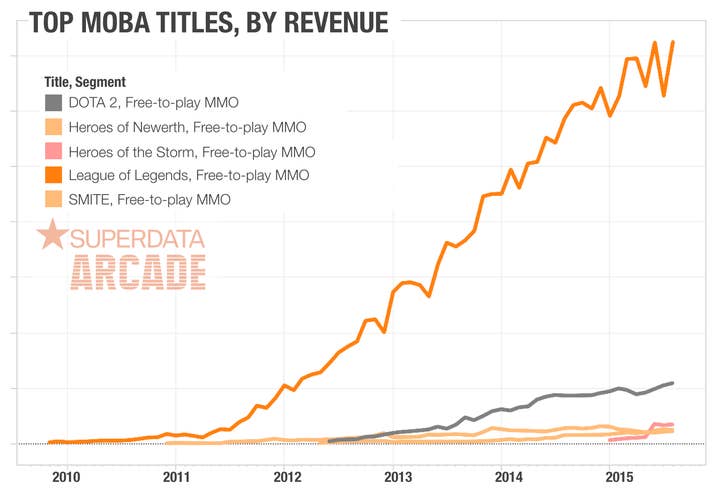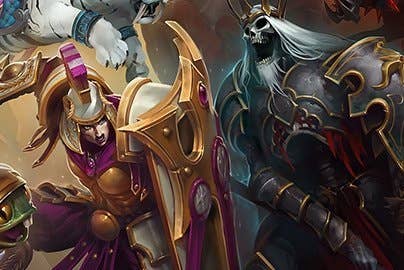Heroes' fate could determine Activision's
SuperData's Joost van Dreunen examines how Heroes of the Storm is faring months after launch and what it means for ATVI
It has been four months since Activision's contender for the MOBA market, Heroes of the Storm, came out. Back in June, we asked: "Can Blizzard's Storm tackle a saturating MOBA market?" Specifically, as this unique and newly emerging market started showing signs of saturation, we looked at whether Heroes was going to take market share from the incumbents or, as the Activision executive team stated during E3, manage to bring new players into the market?
Certainly, Heroes has become a lot more important for Activision, not in the least to stem dwindling subscriber numbers from its World of Warcraft franchise. And now that all of the legacy publishers are aggressively exploring new revenue and distribution models, having a strong performing digital title is key to keeping the confidence of audiences and financial analysts alike. Following the success of Hearthstone, some Wall street analysts are hoping to see Heroes rise to that same level, forecasting revenues of about $200 million by end of next year.
Here's what the data tells us.
"The bigger titles are slowly draining the life out of the smaller ones in the market"
Since we last reported on MOBAs, a few things have changed. For one, the overall market has grown only slightly, 3.9 percent since April, providing further evidence of our previous claim that the market has reached a plateau. Following several years of spectacular expansion, its addressable audience has settled, forcing publishers to compete more aggressively over existing market share. Second, each of the major titles has managed to outpace the market growth rate. During April to August this year, League of Legends grew its monthly active user base by 8 percent, Dota 2 by 11 percent and SMITE by 14 percent. Having reached saturation, the MOBA market is starting to consolidate. In August 2014, the top four MOBA titles accounted for 59 percent of the global market. Today that share is 67 percent. Perhaps seeing the early signs, Electronic Arts had already canceled development of its MOBA contender Dawngate, and earlier this year Turbine/Warner Bros. shut down Infinite Crisis. The bigger titles are slowly draining the life out of the smaller ones in the market.

Despite these rising barriers to entry, Activision showed its confidence by moving forward with the release of Heroes. In part, it was likely the courage gathered from having a whopping 9 million users register for the beta back in February that fueled this decision. As our ability to capture traffic numbers is still at an early stage, the current count appears to have more than doubled, having reached 22 million registered players. Activision's 800-pound marketing machine has so far successfully carried Heroes forward. In fact, in terms of monthly active users, it has already left two of the top titles in the MOBA market, SMITE and Heroes of Newerth, behind. In fairness, however, this was to be expected. Given the strength of Activision's intellectual property and publishing prowess, Heroes is a baby behemoth.
"The real question everyone is looking to answer is, of course, whether a legacy publisher like Activision can truly fully adapt to the new reality of digital gaming"
One thing that has potentially prevented Heroes from reaching a larger audience is a somewhat unfortunate launch period. During the first 90 days--often a critical period in building up momentum in its marketing effort--both the number 1 and 2 in the market held major events. First, in August Dota 2 held its championships, The International, which reached a new record with a fan-funded prize pool of $18 million. Valve's own marketing machine is not to be underestimated, since it relies not on traditional marketing channels, but on the fans and players themselves. Second, August was also the month in which market leader League of Legends had started to ramp up excitement for its own championships in October. While its prize pool may not be as spectacular, League's overall market position and ability to reach a massive audience has allowed it to stay in the public's eye, dominating headlines and marketing channels everywhere. If we look at live streaming channels like Twitch, using it as a proxy for consumer interest for Heroes, we notice that during its release month the concurrent viewer count more than doubled. However, since then, it has dropped back to 46 percent higher than during its pre-release period. The audience for League of Legends viewers, on the other hand, has grown 14 percent during that time, but is roughly 21 times larger in absolute unique viewers.

Obviously, it is far too early to compare Heroes to the number one game in the category. With a monthly active user count of just over 6 million only a few months after launch, Heroes may not seem like much compared to a titan like League of Legends. But consider for a moment that it took League almost two years (21 months) to get to that same level of player activity. Valve's Dota 2 took even longer: 33 months. In those terms, Heroes is currently outperforming everyone.
If we add it all up, we have to conclude that, so far, Heroes of the Storm is doing well. But, to answer our earlier question, rather than bringing new players into the market, Heroes has mostly grown by attracting players already familiar with the genre. What we will be looking for next is Activision making a strong play during its second act. Heroes cannot merely be just another MOBA title, looking to capture market share from a few early movers. Rather, we'd expect the publisher to leverage its other properties.
More broadly, the success of Heroes is tied closely to the success of Activision. If the publisher cannot succeed here, it opens the door to speculation that the giant, which previously did so well in gobbling up market share in the pay-to-play MMO market and collectible card game genre, may have lost some of its edge. The real question everyone is looking to answer is, of course, whether a legacy publisher like Activision can truly fully adapt to the new reality of digital gaming. The absence of larger success--why, for instance, has it not yet released any statements that brag about an overwhelming number of players joining the game?--gives rise to uncertainty. Perhaps even Activision has finally found its match in competitors like Valve and Riot Games. Or maybe we are just now in the quiet before the storm.
